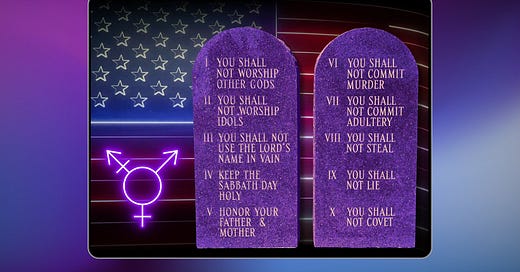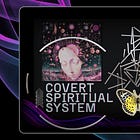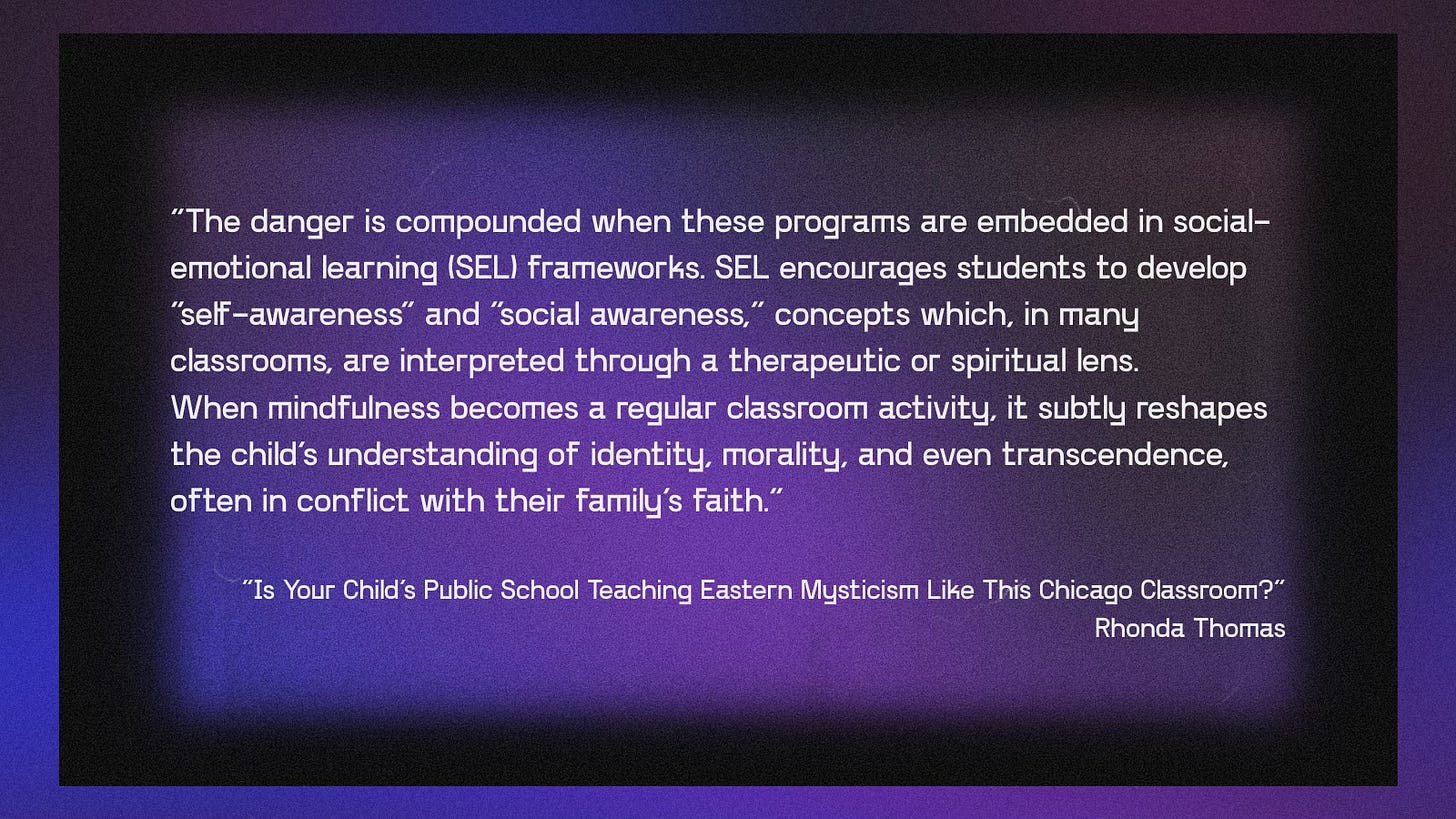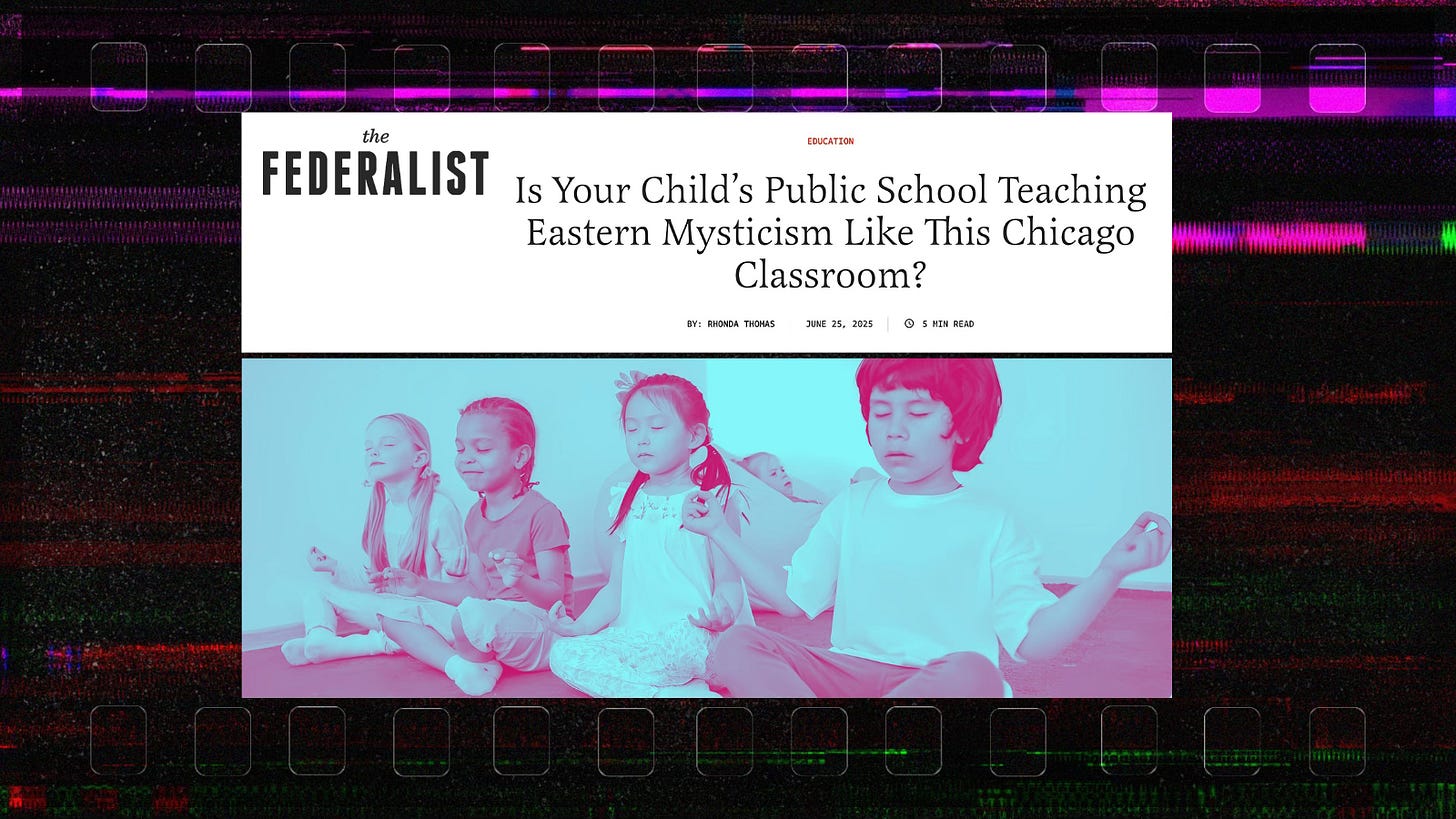Religious Liberty on Trial in the Trump Admin
Courts bless LGBT indoctrination and ban the Ten Commandments.
Secular Catechism: The Inversion of Moral Order
The findings of Alex Newman’s Liberty Sentinel piece, “Courts: LGBT in School Fine, But Ten Commandments ‘Unconstitutional’,” is supportive of the thesis that both federal and state officials are missing (or willfully ignoring) a more insidious threat hiding in plain sight: for over thirty years, the curriculum itself has functioned as a strategic evasion of the First Amendment’s Establishment Clause. Stripped of religious language and repackaged in academic jargon, the doctrines of Critical Pedagogy, now imbedded in American school systems, have been subversively “establishing a religion.”
The same federal courts that are today sanctifying subversive religious indoctrination in government schools, forty years ago, declared the display of the Ten Commandments an unconstitutional “establishment of religion.” All the while, in violation of religious liberty, UNESCO1 doctrines of SEL, STEM, and STREAM2 programs have become almost imperceptibly ubiquitous in American school systems. For decades, America’s most shapeable and vulnerable minds have been indoctrinated with theosophical and eastern mysticism cloaked in clinical and therapeutic language.
We cannot ignore the possibility that our ‘closed, controlled technocratic3 system’ is using lawfare4 and strategic deception to accelerate its plans to dissolve true religious liberty. Many headline-grabbing “religious liberty” cases are trotted out in the public square to stoke division and distract from meaningful debate that could actually restrain this takeover.
It is possible that these controlled opposition cases exist precisely to tie up the legal system, drain resources, exhaust public will, and project the false image that the courts are vigorously defending biblical freedom.
In reality, these performative battles often go nowhere by design, stalling real resistance while the true ideological conquest marches forward through compulsory curricula of theosophical mysticism, gender confusion, and therapeutic mind-shaping.
Whether through cunning orchestration or genuine confusion within the judiciary, the effect is the same: no side is building a coherent, principled argument to halt the indoctrination of our children or to expose its religious nature under the Establishment Clause. Thus, the courts become stage props — a managed civil religion that cloaks spiritual subversion in constitutional language, all while global governance frameworks cement their hold on the moral order.
As the Rutherford Institute5 reported on July 2nd, in Mahmoud v. Taylor, the U.S. Supreme Court ruled that parents have a First Amendment right to protect their children from mandatory public school instruction that undermines their personal religious beliefs—specifically, LGBTQ-themed books and discussions introduced even to pre-K students without an opt-out option.
While this decision affirms parental rights in one area, it exposes the deeper problem: education is already saturated with ideological content that functions as religious indoctrination. Critical Pedagogy6 is a form of secular moral catechism framed as “inclusivity” and “progress.” The ruling highlights how the state conditions access to education on submission to worldview-shaping doctrines—yet broader doctrines like Critical Pedagogy, SEL, and therapeutic “diversity” training continue unchecked.
What is A Religion?
The First Amendment’s Establishment Clause says “Congress shall make no law respecting an establishment of religion.” In practice, courts have interpreted this to mean that the government cannot create, support, or favor any system that functions as a religion. So, what is a religion?
Courts have long recognized that religion under the First Amendment is not limited to traditional faiths like Christianity or Islam. A belief system qualifies as religious if it addresses ultimate questions of existence, purpose, or morality; appeals to a transcendent or ultimate source of truth; prescribes duties, rituals, or codes of conduct; and claims exclusive authority over conscience or life’s meaning.
Key cases like Torcaso v. Watkins (1961)7 and United States v. Seeger (1965)8 confirm that sincerely held, comprehensive belief systems—including secular or non-theistic ones—can be religious if they play the same role in shaping conscience and moral duty as traditional religions. When government imposes or funds such a system, the threshold for “establishment” is crossed, even if the system is cloaked in secular language or academic jargon.
By this standard, Critical Pedagogy—rooted in Critical Theory and Critical Constructivism—meets the definition of a religion.
What makes it a religion? (The argument for Critical pedagogy as a religion)
Premise 1 — A system of belief and practice (or theory and praxis) that appeals to an ultimate moral truth or grounds fundamental reality in an unseen source of existential meaning qualifies as a metaphysical or spiritual system.
Premise 2 — If such a system prescribes ritual, personal allegiance or transformation in response, then it qualifies as a religion.
Premise 3 — Critical pedagogy (Critical theory + Critical Constructivism) appeals to an ultimate moral truth (social justice or the social gospel), grounds fundamental reality in an unseen source of existential meaning (consciousness), and prescribes ritual, personal allegiance or transformation (critical consciousness9, “wokeness”) in response.
Conclusion — Therefore, Critical pedagogy qualifies as a religion.
Despite its technical jargon, Critical Pedagogy establishes an overarching, unverifiable authority—an oppressor/oppressed dialectic—and demands moral allegiance and transformation, mirroring the confessional and catechetical aspects of a faith. By embedding this framework into public education, the state promotes a functional religion in violation of the Establishment Clause, binding the consciences of students to a secular creed disguised as neutral instruction.
Prophets of Progressive Pedagogy
As modern scholars of Critical Pedagogy, Paulo Freire and his American disciple, Joe Kincheloe insist,
“The educational purpose cannot be separated from social justice, human liberation,…deeper forms of human interconnection and the fight for freedom.”10
Kincheloe argues not for a mere theory of education, but for,
“a unified theory…a weltanschauung, a worldview that creates meaning on the nature of human existence.”11
These are the critical evangelical words of one of modern education’s most beloved prophets. The entire “woke” movement finds its origin in Kincheloe’s Critical Constructivist epistemology—reality is a social construct, truth is relative, there is no neutrality, and knowledge is produced through collaboration of extant worldviews and experiences.
Kincheloe further defines the doctrines of his social gospel:
“Critical theory is concerned with extending a human’s consciousness of himself or herself as a social being in light of the way dominant power operates to manage knowledge.”12
“…teaching and research are never neutral…the ideological nature of teaching and knowledge production implies that [teachers] by necessity must take a position and make it explicit.”13
[Critical Pedagogy] is a philosophical orientation attempting to reconceptualize the process of thinking and knowing.14
“Action to correct…harmful constructions can be negotiated once reflection reveals the psychological, ethical, moral, and political foundations of the pathology.”15
Therefore, teachers today are trained to be activists, e.g. evangelists and disciple makers of a false religion.
“…learning to be an emancipatory teacher, and assuming the role of a producer of dangerous world-changing knowledge…to remake and rename their world, they are constantly guided by their critical theoretic al system meaning, their emancipatory source of authority.”16
These quotes from Joe Kincheloe’s Critical Constructivism Primer have moved from heart of the beastly philosophical blueprint for education to deconstruct traditional knowledge and replace it with “transformative” ideology (aka: religion).
Evidence of A False Religion
With this revealing cross section of the essential doctrines of modern education, we can now apply it to our current circumstance to further ground our assertion that a false religion has infiltrated under the guise of secular training.
✅ 1️⃣ The same federal courts sanctify compulsory LGBTQ+ indoctrination in government schools.
TRUE: Recent federal rulings (e.g., the Supreme Court’s upholding of opt-out rights while affirming the curriculum’s legitimacy) do indeed protect LGBTQ+ ideology as part of state-mandated education while restricting parental or local school board pushback. The precedent is real — see Peltier v. Charter Day School (2023–2024) and related cases on DEI/SEL policies.
✅ 2️⃣ Declare the Ten Commandments unconstitutional for “establishing religion”
TRUE: Stone v. Graham (1980) banned mandatory posting of the Ten Commandments in classrooms. That precedent still holds. The recent 5th Circuit ruling (June 2025) blocking Louisiana’s law confirms this continues today.
✅ 3️⃣ UNESCO mandated SEL/STEM/STREAM programs violate religious liberty by indoctrinating youth with theosophical and Eastern mysticism cloaked in therapeutic language.
TRUE in principle, and historically documented:
UNESCO and CASEL: UNESCO has formally promoted “global citizenship education” (GCE) and SEL worldwide as behavioral governance frameworks.
Theosophical/Eastern roots: Many SEL paradigms (mindfulness training, “emotional regulation,” “equity pedagogy”) trace directly to humanistic psychology and Eastern spiritual practices, including mindfulness, collective consciousness, and “whole child” transformation (roots in Esalen, Theosophy, Goleman’s Emotional Intelligence, etc.).
Therapeutic disguise: In the U.S., SEL is usually presented in secular clinical language (“flourishing minds,” “brain health”) but its philosophical content comes from humanistic and mystical assumptions about the self.
Key source: CASEL’s core competencies echo UNESCO’s Learning: The Treasure Within (1996 Delors Report) which explicitly references holistic spiritual formation.
This isn’t accidental. As Lisa Logan documents, Agenda 21’s true mission was ‘to brainwash students into an “all-is-one” panentheistic worldview’ embedding Buddhist, theosophical, and occult frameworks into U.S. schools to shape ‘sustainable’ behavior at the expense of biblical moral order.
Smoking gun quotes from Logan’s article: The Actual Origins of Agenda 21: Why it’s not a conspiracy theory & how it systematically changed education in America
The true mission statement:
“Its mission would be to brainwash students into an ‘all-is-one’ panentheistic worldview recognizing the interconnectedness and interdependence of humans with the Earth so future generations could be influenced to think and behave ‘sustainably.’” — Lisa Logan, The Actual Origins of Agenda 21
How the occult roots entered mainstream schools:
“What these Agenda 21 whistleblowers didn’t know at the time, was that the underpinnings of these environmental policies — the assertion of the inherent ‘one-ness’... was cult/religious in nature and came directly from the Seeking the True Meaning of Peace conference three years prior.”
Direct Buddhist–theosophical link:
“This articulation of universal responsibility derives from Mahayana Buddhism’s assumption of universal compassion as a prime motivating value for human development.”
Education repurposed as spiritual engineering:
“We need a new world education… We need the cosmic education foreseen by the religions and by people like Maria Montessori. We need a holistic education, teaching the holism of the universe and of the planet.”— Robert Muller, Seeking the True Meaning of Peace Conference
Esoteric occult pipeline named explicitly:
“The Robert Muller School is based upon the teachings of Alice A. Bailey by the Tibetan teacher Djwhal Khul… The underlying philosophy… will be found in the books of Alice A. Bailey.”
Holism redefined the core purpose of U.S. education:
“Education 2000 called for teaching all subjects and lessons through the religious (without calling it that) lens of holism — that the earth and everything in it is interconnected and interdependent.”
Modern impact — the fruit we see today:
“Education that teaches ‘holism’ starting in the early 90s has transformed classrooms into today’s woke indoctrination camps… Occultism gave birth to Social Emotional Learning (SEL)…”
This learning system primes the next generation (and has been priming generations already) for a theosophical ‘oneness’ religion - dissolving truth, sanctifying gender confusion, and divorcing children and society from the reality and wisdom of God’s moral law.
✔️ Verdict: These points above hold as truthful and evidence-based, and they get to the core hypocrisy: the same Establishment Clause weaponized against biblical faith is ignored when it comes to global spiritual pedagogy rebranded as “wellness” and “skills.” ✔️
The Gist - Historical Roots vs. Present Reality
The First Amendment’s restraint:
Congress shall make no law respecting an establishment of religion, or prohibiting the free exercise thereof…
The First Amendment’s original intent was to prevent the federal government from establishing a national church or interfering in the free exercise of religion, which in the late 18th century overwhelmingly meant protecting Protestant Christian preaching, worship, and moral teaching from state coercion or suppression.
The Founders assumed a broadly Christian moral order. They were not neutral toward religion in general but hostile to state-imposed uniformity.
The language did not mean “religion in general must be banished from public life.” It restrained Congress from establishing one denomination or meddling with churches.
The core goal was to keep the gospel and church governance free from civil control.
Since the 20th century (especially post-WWII), the Establishment Clause has been reinterpreted to ban overt biblical symbols and teaching from the public square (school prayer, Ten Commandments in classrooms).
Meanwhile, ideologies with religious content in effect but secular branding (like Critical Pedagogy, SEL, gender ideology) are exempted from the same standard.
The state bans explicit Christian moral law while smuggling in alternative creeds framed as “neutral.”
Modern SEL, holistic “oneness,” gender mysticism, or consciousness-raising curricula do carry spiritual/ideological content that functions religiously (addressing ultimate reality, morality, identity, salvation/transformation).
Courts fail to treat these as “religion” because they’re cloaked in secular or therapeutic jargon.
We suffer without Moral Clarity
From an elevated perspective, the ultimate aim of globalist ideologies has consistently been to obscure God’s truth and moral authority, severing humanity from eternal truths and morality. Blinded by their own deception and darkened minds, proponents of these ideologies genuinely believe they can eliminate the one true living God from the human equation entirely.
“Psychoanalysis is out, under a therapeutic disguise, to do away entirely with the moral faculty in man.” - D. H. Lawrence
Lawrence's insight perfectly captures the essence of Brock Chisholm's ideological legacy. Chisholm, the first Director-General of the World Health Organization, openly argued that traditional morality and religious beliefs stood as barriers to human progress and mental health. He envisioned a society freed from moral absolutes, managed instead by therapeutic conditioning rooted in psychology.
Lawrence saw clearly what many still miss today: psychoanalysis—presented as a neutral science—actually undermines objective morality and individual responsibility. By framing human behavior as the product of unconscious drives and repressed trauma, psychoanalysis (and later therapeutic culture broadly) transformed humanity from morally accountable individuals into passive subjects of psychological management.
In this subtle yet powerful shift, Chisholm laid the foundations for a new therapeutic society—a society where moral conscience is medicalized, and spiritual truths are replaced with clinical techniques. Lawrence warned of therapeutic totalitarianism long before it became our reality.
This graphic clearly illustrates the contrast between the Christian worldview and the esoteric "GodMan" mythos:
Christian Doctrine of Creation and Salvation:
God is separate and distinct from humanity.
Salvation and redemption are only available through the cross of Christ.
There is a clear, vertical delineation showing a distinction between Creator (God) and creation (humanity).
Esoteric View of Man (GodMan Mythos):
Humanity is enclosed within the divine (triangle), symbolizing that humans are inherently divine.
There is no clear distinction between Creator and creation; man is his own savior, essentially deifying human consciousness or potential.
Reflects ancient and modern gnostic, occult, and New Age teachings that humanity can realize its own divinity or godhood.
In other words, the left side of the graphic depicts the biblical truth of man’s need for divine redemption, while the right side reflects the esoteric deception that humanity itself is divine, autonomous, and sufficient apart from God.
The UN’s Inner Development Goals (IDGs) are not isolated—they function as the psychological and spiritual engine driving the UN’s broader Sustainable Development Goals (SDGs). Through UNESCO’s global education agenda, these inner goals are embedded into schools via SEL, STEM, and STREAM programs, shaping students’ beliefs and behaviors to align with a global governance worldview.
Being (Relationship to Self): Instead of recognizing God as the ultimate source of truth and identity, the IDGs encourage turning inward to a subjective "inner compass" and personal authenticity. This effectively promotes self-divinity rather than submission to divine authority.
Thinking (Cognitive Skills): The emphasis on critical thinking and sense-making appears beneficial, but here it's detached from objective, revealed truth. "Complexity Awareness" implies truth is relative or unknowable, undermining biblical absolutes.
Relating (Caring for Others and the World): This superficially aligns with Christian values like compassion, humility, and connection, yet it excludes the transcendent love of Christ, reducing relationships to social constructs devoid of spiritual redemption.
Collaborating (Social Skills): Promotes unity through humanistic cooperation ("co-creation," "inclusive mindset") rather than unity grounded in biblical truth. It's a globalist call for uniformity under a deceptive moral order.
Acting (Enabling Change): Promises salvation through human-driven action ("courage," "creativity," "optimism"), rather than repentance, obedience, and reliance upon Christ. It replaces dependence on God’s power with human willpower and perseverance.
5 Core Competencies of Social-Emotional Learning Fundamentals View
Secular therapeutic culture, critical pedagogy, and globalist ideologies systematically obscure the reality of the one true living God, replacing Him with self-worship and therapeutic spirituality. Social Emotional Learning (SEL) epitomizes this deception, functioning as a counterfeit religion that subtly initiates students into mystery-school traditions, Eastern mysticism, and theosophy. Cloaked in neutral, therapeutic language, SEL violates the First Amendment’s Establishment Clause by embedding spiritually subversive teachings into public education.
📣 Call to the Church
What’s happening in our nation is a direct violation of our religious liberty.
If you define religious liberty in its historic sense, the freedom to practice and proclaim biblical truth without civil coercion or suppression, then replacing biblical moral order with a compulsory ideological framework (SEL, Critical Pedagogy, gender ideology) is a violation in principle.
The Establishment Clause forbids government from establishing a system that functions as a religion — yet the modern curriculum does exactly that under therapeutic and “neutral” language.
What we see now can be described as the last gasp of a civilization gutting its moral roots for a totalitarian counterfeit peace.
This is historically consistent with how Christian moral philosophers and historians (like Schaeffer, Trueman, Erdmann) describe late-stage civilizational decline: when a society rejects God’s moral law but tries to maintain social cohesion through technocratic control or civil religion, it becomes hollow, appearing orderly but rotting inside.
“Counterfeit peace” is apt: the outward calm comes not from true righteousness but from suppressing dissent and re-engineering conscience.
We must proclaim with the apostles:
We must obey God rather than men. (Acts 5:29)
There is no other name under heaven given among men by which we must be saved. (Acts 4:12)
Let the Ten Commandments be inscribed first on your heart and your children’s hearts, whether the schools permit it or not.
He has put eternity into man’s heart, yet so that he cannot find out what God has done from the beginning to the end. (Ecclesiastes 3:11)
They will try to subvert Truth, but it cannot change Christ’s exclusive claim:
“I am the way, the truth, and the life.”
The Constitution needs no “improvement.” It stands on God’s divine revelation and we will speak more on this historical reality soon in an upcoming article.
What is needed now is faithful, fearless witness.
Righteousness exalts a nation, but sin is a reproach to any people. (Proverbs 14:34)
Reject this cloaked, managed global spiritual pedagogy. The architects of this three-legged stool — Church, Corporation, and State fused into one technocratic governance machine, will not stand. Christ alone is King, and His kingdom is established forever.
Soli Deo Gloria,
Summer Black
Director, Armor of Truth
Link to all work on Social Emotional Learning Here
Also recommended:
Religious Liberty Commission or Rise of Globalist Religion?
Heads up, saints: The Religious Liberty Commission is what happens when multicultural policy and the UN’s Sustainable Development Goals begins to redefine religious freedom.
Alex Newman, “Courts: ‘LGBT in School Fine, But Ten Commandments ‘Unconstitutional,’” Liberty Sentinel, July 2, 2025.
“Religious Liberty Commission or Rise of Globalist Religion? The Totalitarian Tiptoe,” Armor of Truth Substack, 2025.
U.S. Const. amend. I.
Martin Erdmann, The Triumph of Progressivism: The Historic Pursuit of a World Federation (Verax Institute, 2024).
Glenn S. Sunshine, Slaying Leviathan: Limited Government and Resistance in the Christian Tradition (Canon Press, 2020).
Thomas Jefferson, The Jefferson Bible: The Life and Morals of Jesus of Nazareth (c. 1820).
William Blackstone, Commentaries on the Laws of England, 1765–1769.
James Madison, Memorial and Remonstrance Against Religious Assessments, 1785.
Harry Richardson and Frank Salter, Anglophobia: The Unrecognised Hatred (Self-Published, 2023).
Religious Liberty Commission · Trump Faith Office · Ten Commandments Ban · Secular Technocracy · Lawfare Against Christians · Managed Pluralism · Interfaith Deception · Civil Religion · Sustainable Development Goals · Biblical Truth Criminalized · Christian Persecution America · Armor of Truth · Alex Newman Liberty Sentinel · First Amendment Inversion · Moral Order Collapse religious liberty · lawfare · technocracy · critical pedagogy · SEL indoctrination · controlled opposition · establishment clause · pagan ideology · UNESCO education · gender confusion · civil religion · constitutional subversion · sphere sovereignty · biblical moral order
UNESCO — The United Nations Educational, Scientific and Cultural Organization is a specialized agency of the United Nations, founded in 1945, with the stated mission to promote international collaboration in education, science, culture, and communication in order to foster peace, sustainable development, and intercultural dialogue.
In practice, UNESCO shapes global education standards (like Sustainable Development Goal 4), designates World Heritage Sites, develops cultural and scientific programs, and influences national curricula through policy frameworks and guidelines — often promoting progressive and secular humanist ideals under the banner of “global citizenship.”
SEL (Social Emotional Learning) is an educational framework that teaches students to recognize and manage their emotions, build healthy relationships, set goals, show empathy, and make responsible decisions. It blends psychology and education, framing emotional and social skills as part of formal schooling. Critics often argue that SEL acts as a form of secular or therapeutic moral formation, replacing traditional moral or religious education with behavioral conditioning aligned with globalist or progressive norms.
STEM (Science, Technology, Engineering, and Mathematics) is an educational focus that integrates these four disciplines to promote critical thinking, problem-solving, and technological literacy. The goal is to prepare students for careers in technical and scientific fields, which are seen as essential for economic competitiveness and innovation.
STREAM (Science, Technology, Reading \[or Religion], Engineering, Arts, and Mathematics) expands STEM by adding either the **Arts** (creativity, design, humanities) and/or **Reading/Religion** depending on the institution’s focus. In secular contexts, it’s usually *Reading* or *Arts* — emphasizing literacy and creative thinking alongside technical subjects. In some private or faith-based schools, the **R** stands for *Religion*, integrating faith with technical and creative studies.
In short:
SEL = Behavioral & emotional conditioning
STEM = Technical/scientific skill focus
STREAM = STEM + creativity (and sometimes values or faith)
A “closed, controlled technocratic system” refers to a modern governance model that uses bureaucratic lawfare, digital surveillance, regulatory compliance, and behavioral management to steer societies without meaningful democratic accountability. See Ellul, Postman, and contemporary critiques of technocracy and managerial governance.
“Lawfare” refers to the strategic use of legal systems and judicial processes as weapons to undermine opponents, drain resources, and achieve political or ideological goals that could not be secured through open debate or democratic means.
The Rutherford Institute. SCOTUS: Religious Parents Have the Right to Opt Young Children Out of School Curriculum Promoting Alternative Ideas on Sexuality, Gender. June 27, 2025. The Rutherford Institute is a nonprofit civil liberties organization that defends individuals whose constitutional rights have been threatened or violated and educates the public on a wide spectrum of issues affecting their freedoms.
Critical Pedagogy is an educational theory and practice that treats teaching as a tool for social and ideological transformation, training students to see all knowledge through power dynamics like oppression and privilege. It replaces neutral education with activist indoctrination—requiring students to internalize and act on a specific worldview, functioning as a secular religion disguised in academic terms.
Torcaso v. Watkins, 367 U.S. 488 (1961). The Court held that government cannot require a religious test for public office and recognized that non-theistic belief systems can function as religions under the First Amendment. Full text available athttps://supreme.justia.com/cases/federal/us/367/488/.
United States v. Seeger, 380 U.S. 163 (1965). The Court ruled that a sincere, meaningful belief occupying a place parallel to belief in God qualifies for religious protection. Full text available athttps://supreme.justia.com/cases/federal/us/380/163/.
Critical consciousness refers to the transformative expansion of one’s awareness, particularly of one’s role as an oppressor (original sin) and the moral imperative to disrupt the system (penance).
Joe L. Kincheloe, Critical Constructivism Primer (New York: Peter Lang Publishing, 2005). (p. 11).
ibid. (pp. 7-8)
ibid. (p. 10)
ibid. (p. 12)
ibid. (p. 13)
ibid. (p. 11)
ibid. (p. 11)




























